Why Are Art Mueseums Set Up the Way They Are
When people think of museums, art museums most ofttimes come up to heed—solemn places where visitors stand in silence contemplating neat rows of paintings. The exploratory, hands-on science center, the contextualized ethnographic drove (think dioramas), and the storytelling of history museums seem worlds away. But all museums have a history to tell. Museums are more than containers of things; rather, they are complex reflections of the cultures that produced them, including their politics, social structures, and systems of thought.
The word "museum" comes from the 9 Muses, the classical Greek goddesses of inspiration, though the famed "Museion" of ancient Alexandria was more similar a university, with an important library, than a place for the brandish of objects. While scholars generally identify the earliest museum (in the sense that we understand information technology today) in 17 thursday or 18 th -century Europe, there were earlier collections of objects and sites of display, including the public squares or fora of ancient Rome (where statuary and state of war booty were exhibited), medieval church building treasuries (for sacred and valuable objects), and traditional Japanese shrines where small paintings ( ema , traditionally of horses) were hung to draw skillful favor.
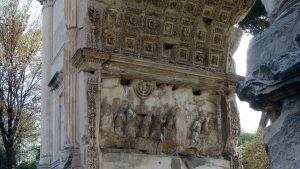
Relief panel showing The Spoils of Jerusalem existence brought into Rome after 81 C.E., marble, 7 feet, 10 inches high on the Arch of Titus, in the Roman Forum, erected past Emperor Domitian after the death of his brother Titus in 81 C.E., commemorating the capture of Jerusalem by Titus in 70 C.E. (photo: Steven Zucker, CC BY-NC-SA two.0)
The modern museum, as a secular infinite for public appointment and instruction through the presentation of objects, is tightly bound to several institutions that arose simultaneously in 18 th and 19 th -century Europe: nationalism fused with colonial expansion; democracy; and the Enlightenment. Thus this historical essay and several others in this series on museums focus largely on Europe and North America. The influence of the museum model, equally a tool of colonialism but also as a site for local adaptation and self-definition in places other than the West, are two sides of an important coin that is just get-go to receive attention from art historians.
Wunderkammern
The nearest thing to a museum in early on modern Europe were the Wunderkammern , or cabinets of wonders, assembled by curious nobles, wealthy merchants, and scholars. Emerging just equally Europe was extending its reach into "new" continents and cultures, Wunderkammern were places to gather together, interpret, and show off the riches of the world. Some were literal cabinets, fitted with cupboards and drawers; others were rooms stuffed with animal, mineral, vegetal, and artistic treasures. Much like our museums—and differently from church building treasuries and displays of state of war haul— Wunderkammern were intended to deepen people'southward cognition through the presentation of things.
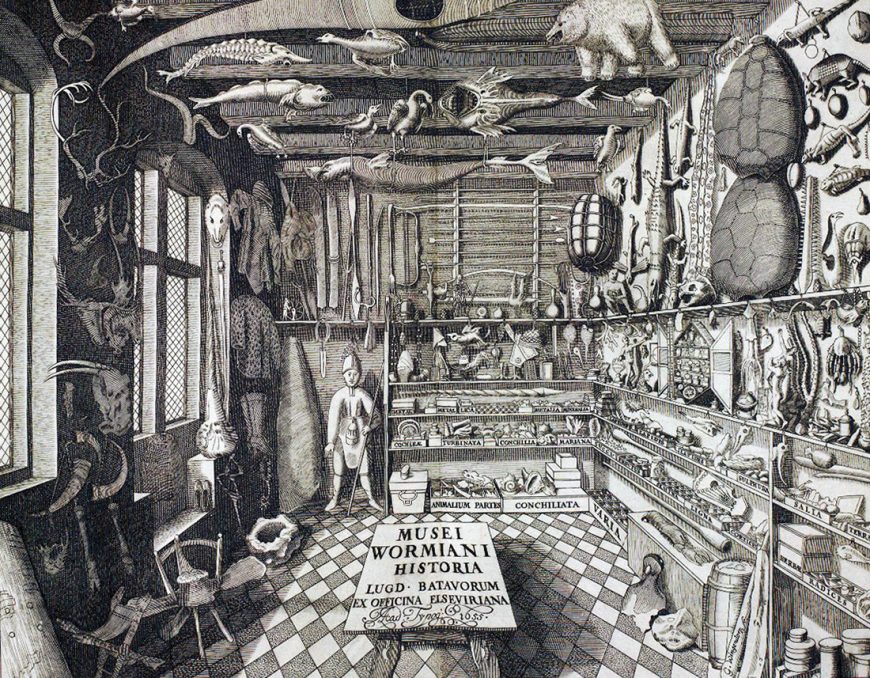
Frontispiece depicting Ole Worm'south cabinet of curiosities, from Museum Wormianum, 1655 (Smithsonian Libraries). Ole Worm was a Danish physician and natural historian. Engravings of his drove were published in a volume after his death.
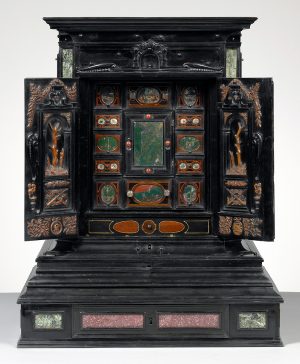
Display chiffonier from Augsburg, Germany, c. 1630, ebony and other woods, porphyry, gemstones, marble, pewter, ivory, os, tortoiseshell, enamel, mirror drinking glass, contumely, and painted rock, 73 x 57.9 x 59.1 cm (The J. Paul Getty Museum)
In most other means, nevertheless, Wunderkammern differed from modernistic museums. They were the domains of the wealthy aristocracy, typically located in a private palace and open but to the collector, his firsthand circle, and the occasional company who was properly furnished with a letter of the alphabet of introduction. This intimacy meant that objects could be taken from shelves, handled, juxtaposed, and discussed earlier being returned to storage, often out of sight. Wunderkammern were more like private study collections than the art museums most of us know today.
As is truthful of all museums, the organization of the Wunderkammern mirrored the intellectual outlook of their day. "Wonders"— extraordinary objects like featherwork from New Spain or a spiraled unicorn horn (actually the tusk of a narwhal)—were among the near valued, as marvelous expressions of creation. At the aforementioned time, Wunderkammern were extensive, ideally including every kind of object, both natural and bogus (i.eastward. fabricated past homo hands) from every corner of the world.
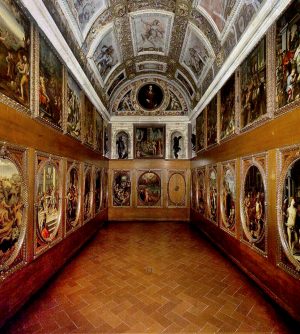
The studiolo of Francesco I in the Palazzo Vecchio, Florence. Though it is empty now except for the paintings on the walls and ceiling, it originally contained Francesco I'south drove of rare objects. (Photograph: Web Gallery of Art, CC 0)
Wunderkammern were seen as "microcosms" of God'south creation: the cosmos , Greek for "universe," was encapsulated in one, miniaturized reflection of its literal awesomeness. This was an age of rising scientific involvement, merely this interest was still thickly wrapped in religious covers. In the worldview of aristocracy European collectors, all elements of the creation were interconnected in a perfectly balanced web of meaning. If one laid out a Wunderkammer in faux of this divine plan, the program would be revealed. Francesco I de' Medici of Florence , for case, probably bundled his drove according to the 4 Aristotelian elements: globe, air, fire, and water. Objects every bit varied as armor, mirrors, and enamels were linked as fire-objects (since they were created using heat), pearls and narcotics (typically diluted for use) as water-objects, and and then along. Other Wunderkammern had other organizational systems, but they were typically rooted in visual or conceptual resemblance (e.chiliad. fire=forge=armor).
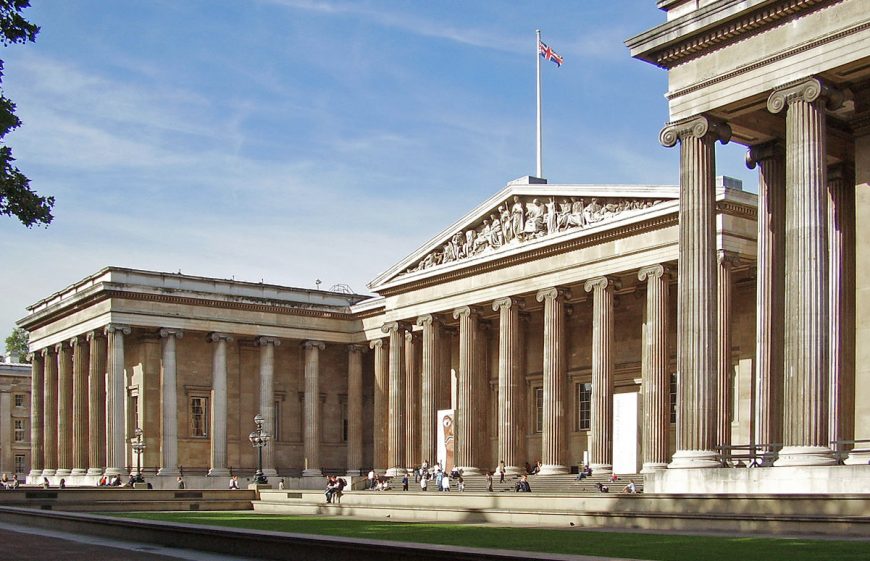
Robert Smirke, due south portico of the British Museum, 1846-47 (photo: Ham, CC Past-SA three.0)
The British Museum and the Enlightenment
Toward the middle of the eighteenth century a unlike structure emerged, one associated with several of import trends. One of these was the rise of the Enlightenment. This intellectual movement aimed to brand sense of a world that— from the perspective of Europeans who were colonizing other places around the globe—was revealing new things that demanded new explanations. Enlightenment thinkers relied on the emerging tools of secular empiricism, or sense-based show, and proof through repetition—that is, the guiding concepts that lie at the root of modern science.
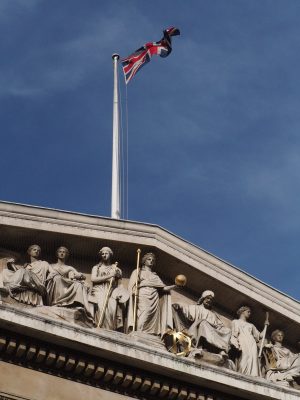
Richard Westmacott, The Progress of Civilisation, pediment of the s portico of the British Museum, 1850s (photograph: Matt Lancashire, CC By-NC two.0)
The British Museum embodies the ethics of the Enlightenment. Founded in 1750 every bit a gift to the British nation by Sir Hans Sloane, its cadre collection consists of specimens he acquired every bit a medical doc in the Due west Indian colonies (plants, birds, and seashells, for example) and objects he purchased from other explorers (including ethnographic and archaeological objects and manuscripts). These were somewhen housed in an imposing building that featured an paradigm of Britannia, the personification of the British Empire, at the apex of its great triangular pediment. This architectural reference to classical temples was intentional, symbolizing a space of protection and prestige, and the nationalist imagery above its entrance made information technology articulate just who controlled the materials within—much of it from the colonies.
The British Museum inherited the spread-out arroyo to collecting characteristic of the Wunderkammern , though it focused on typical objects, or specimens, equally much equally exceptional ones. Not for goose egg are the British Museum and its kin termed "encyclopedic" (encyclopedias were some other production of the 18 th century). Rather than mirroring the balanced, interwoven web of the divine microcosm, still, the new sciences emphasized differentiation and development as tools for an empirical understanding of the universe.
The rise of museums
Museums reflected and helped shape that outlook. The Enlightenment is when we brainstorm to see specialized collections, including museums devoted only to art—the Capitoline (Rome, 1734), the Louvre (Paris, 1793), and the Alte Pinakothek (Munich, 1836). Similarly, dedicated collections of plants (botanical gardens), animals (zoological gardens), and eventually natural history and ethnographic objects emerged. One cardinal thing these collections shared was a scheme of linear, didactic layouts dedicated to narratives of development or progress.
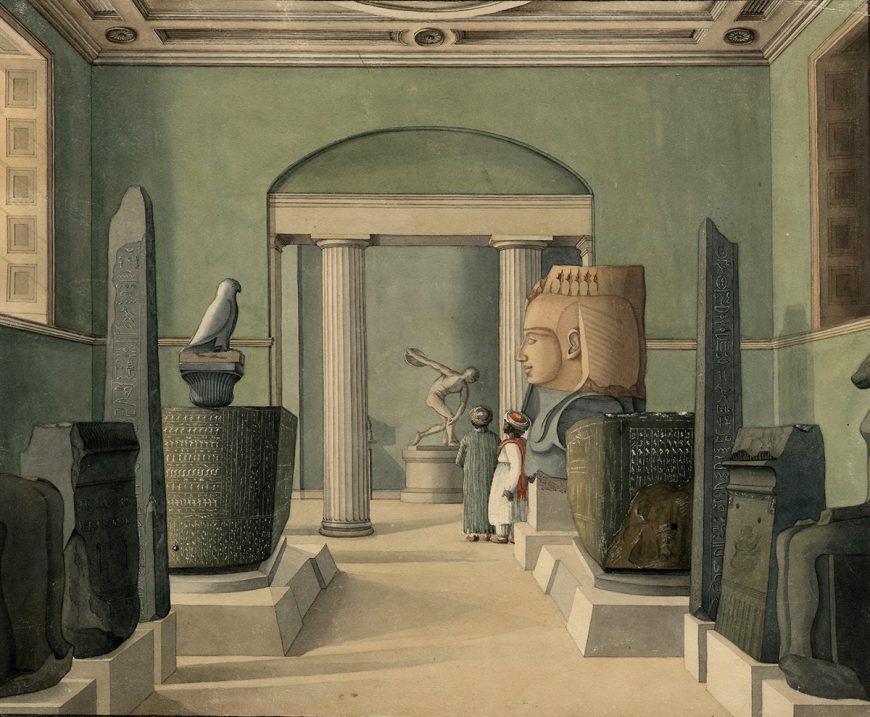
View through the Egyptian Room in the Townley Gallery at the British Museum, 1820, watercolor, 36.one ten 44.3 cm (The British Museum).
In art museums, this meant chronological arrangements subdivided by nation, local school, and artist and based in the comparison of visual forms: for instance, the thought that ancient art leads to the Renaissance, which leads to French Neoclassisicm, or that Egyptian fine art was less "developed" than Greek art. Using different examples, this same history of art could be repeated in different places, much similar a scientific demonstration or a proof. A similar full general narrative continues to ascertain many fine art museums today.
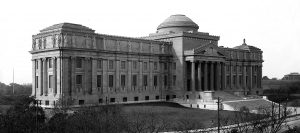
The Brooklyn Museum, c. 1905, dry plate negative, 8 ten 10 inches (The Library of Congress). Founded in 1895, edifice designed by McKim, Mead, & White.
The "white cube"
In the newly formed United States, art museums were an unimagined luxury until the later decades of the nineteenth century, when wealthy patrons in rapidly expanding American cities began to emulate European models. This is why so many historic American museums resemble their European counterparts (temple-fronted facades over a grand staircase), echo their collecting habits (classical sculpture, Renaissance painting, etc.), and mimic their approach to layout and installation.
Even so it was in the The states that some of the about influential trends in modern art museums too emerged. One of these is the "white cube" approach which, despite precedents in Europe, was nigh fully exploited at The Museum of Modernistic Fine art in New York City in the 1930s under the direction of Alfred H. Barr. By minimizing visual distractions, Barr hoped to straight viewers toward a pure experience of the fine art work. The blank spaces, white walls, and minimalist frames he used are at present so common that we hardly observe them.
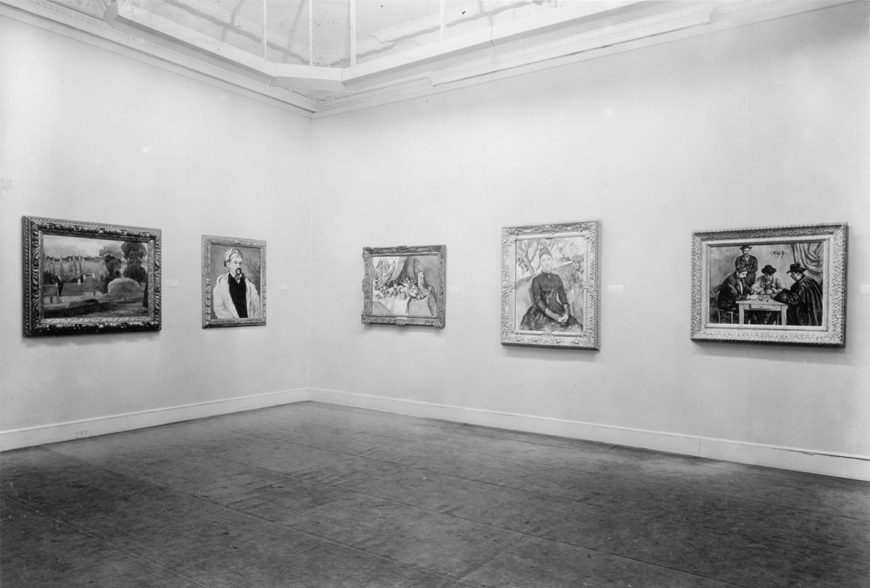
Installation view of Modern Works of Art: 5th Ceremony Exhibition, MoMA, November 19, 1934–January 20, 1935 (The Museum of Modern Art)
The "white cube" was rooted in a philosophy that aimed to liberate art and artists from the conservative forces of history. Ironically, this model has taken over, and art museums from Rio to Abu Dhabi to Shanghai draw on like exhibition tactics. This has led some museum critics to wonder if the "white cube" has itself become a vehicle of cultural control.
Another less recognized pioneer, but one receiving renewed attention, is John Cotton fiber Dana, founder of the Newark Museum in Newark, New Jersey (1907). Dana rejected what he called the "made-to-order museum," that is, a museum that just replicated European models. He believed collections should serve local audiences, responding to their needs and wants. Today many art museums are following Dana'due south philosophical lead, developing collections that reflect the ethnic brand-upwardly of the communities they serve and striving to welcome anybody into their galleries.
An art museum defended to serving the intellectual, spiritual, and social demands of a diverse community is worlds away from the elite microcosm of the early modern Wunderkammer . Yet, like its ancestors, it is a reflection of the world that produced it, and it tells us as much most the history of its—and our—times every bit information technology does about the things it contains.
Additional resources:
Museums and History, from Making History
Within the Lost Museum, an interactive timeline of museum history
John Cotton fiber Dana, "The Gloom of the Museum" (1917). Republished in Gail Anderson, ed. Reinventing the Museum: Historical and Contemporary Perspectives on the Paradigm Shift (Walnut Creek, Cal.: Rowman and Littlefield Publishers, Inc., 2004), pp. xiii-29.
Larry J. Feinberg, "The Studiolo of Francesco I Reconsidered," in The Medici, Michelangelo and the Art of Late Renaissance Florence ( New Haven and London: Yale Unviersity Printing, 2003), pp. 67-76.
Paula Findlen, "The Museum: Its Classical Etymology and Renaissance Genealogy." Journal of the History of Collections , vol. 1, issue 1 (Jan, 1989), pp. 59-78.
Carol Paul, ed., The Starting time Modern Museums of Fine art: The Nascence of an Institution in 18 th – and 19 th -Century Europe (Los Angeles: Getty Publications, 2012).
Source: https://smarthistory.org/a-brief-history-of-the-art-museum/
0 Response to "Why Are Art Mueseums Set Up the Way They Are"
Post a Comment